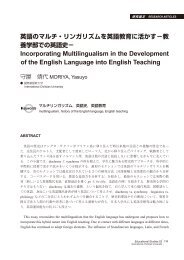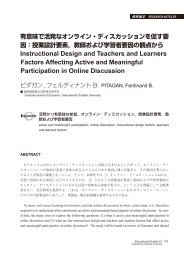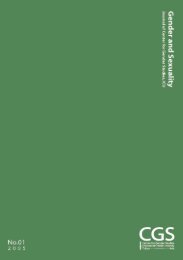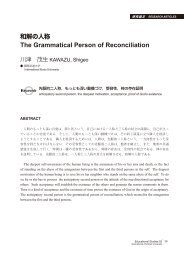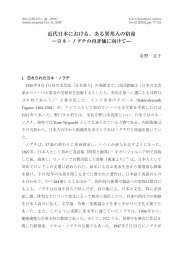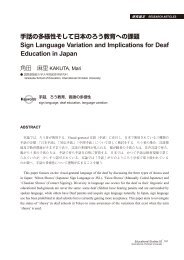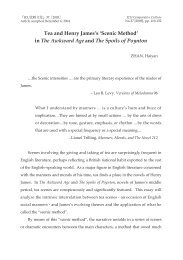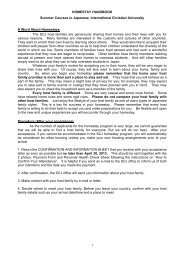Colonial Adaptations in Tropical Asia: Spanish Medicine ... - icu.ac.jp
Colonial Adaptations in Tropical Asia: Spanish Medicine ... - icu.ac.jp
Colonial Adaptations in Tropical Asia: Spanish Medicine ... - icu.ac.jp
You also want an ePaper? Increase the reach of your titles
YUMPU automatically turns print PDFs into web optimized ePapers that Google loves.
O.P., Bishop of Manila, reported <strong>in</strong> 1590 that the Ch<strong>in</strong>ese <strong>in</strong> the Parian 23) had numerous<br />
shops advertis<strong>in</strong>g doctors and apothecaries. 24) He even added that a Ch<strong>in</strong>ese<br />
convert, a physician and herbalist was hired by the Dom<strong>in</strong>icans <strong>in</strong>to the Ch<strong>in</strong>ese<br />
hospital. 25) From Bishop Salazar’s report, it may be <strong>in</strong>ferred that at least <strong>in</strong> the<br />
Dom<strong>in</strong>ican hospital <strong>in</strong> the Parian, Ch<strong>in</strong>ese drugs and medic<strong>in</strong>es may have most<br />
likely been used. In general though, the purchase and usage of Ch<strong>in</strong>ese medic<strong>in</strong>es<br />
depended upon the volition of <strong>in</strong>dividual patients, be they <strong>Spanish</strong>, Filip<strong>in</strong>o, or Ch<strong>in</strong>ese,<br />
as there are no conclusive reports of their widespread usage <strong>in</strong> the other hospitals<br />
<strong>in</strong> and around Manila.<br />
Friar Works on Local Remedies<br />
Recognis<strong>in</strong>g the overwhelm<strong>in</strong>g reality of the lack of medical and pharmaceutical<br />
supplies and professionals, many religious missionaries thus surveyed the countryside<br />
catalogu<strong>in</strong>g the botanical landscape with the objective of discover<strong>in</strong>g and us<strong>in</strong>g<br />
alternative cures. The pa<strong>in</strong>ful reality of the lack of medical supplies was felt <strong>in</strong> the<br />
rural areas, among numerous patients who did not possess the ability to travel to the<br />
metropolis to seek the aid of <strong>Spanish</strong> physicians. 26) The easiest recourse for the poor<br />
patients was to seek traditional therapy provided by the local matanda 27) or the<br />
mediquillo, who from the po<strong>in</strong>t of view of the Spaniards, were <strong>in</strong>accurate therapists,<br />
and at times opportunists and scallywags. 28) It is from these same curanderos and<br />
with the desire to aid the impoverished sick, with which the friars would develop a<br />
state-of-the-art medical and pharmaceutical science unique to the islands dur<strong>in</strong>g the<br />
period.<br />
Curandero Art becomes Missionary Medic<strong>in</strong>e<br />
Fr. Pedro Chir<strong>in</strong>o, S.J. (1604) <strong>in</strong>directly attested to the wealth of pharmaceutical<br />
resources available <strong>in</strong> the islands when he stated that it was “the very desire to secure<br />
drugs that caused the Spaniards, or Castilians, to discover and settle the<br />
Filip<strong>in</strong>as.” 29) Medic<strong>in</strong>al plants were known to be abundant <strong>in</strong> the Philipp<strong>in</strong>e islands,<br />
but their proper usage was orig<strong>in</strong>ally a mystery wielded by the local traditional healers.<br />
The Spaniards used the umbrella term “curandero” to refer to the local traditional<br />
healers who used herbology, hydrotherapy, massage therapy, and div<strong>in</strong>ation as<br />
methods to cure ail<strong>in</strong>g patients. They were sometimes <strong>in</strong>terchangeably referred to<br />
as mediquillos, a generic term applied to <strong>in</strong>dividuals who had a trickl<strong>in</strong>g of western<br />
medical tra<strong>in</strong><strong>in</strong>g and experience, could prescribe medic<strong>in</strong>es, but devoid of the supernatural<br />
heal<strong>in</strong>g feature. 30) The apparent need of the friars to learn the heal<strong>in</strong>g<br />
arts went to certa<strong>in</strong> extents as necessitated. In Leyte, Fr. Cristobal Enriquez, S.J.<br />
studied from the local practitioners by generously pay<strong>in</strong>g them, short of brib<strong>in</strong>g<br />
them. 31) For the time be<strong>in</strong>g, the parish priests became <strong>in</strong>terns and partners of the<br />
curanderos, herbolarios, matandas, and/or mediquillos <strong>in</strong> the quest to provide alternative<br />
heal<strong>in</strong>g solutions to suffer<strong>in</strong>g patients <strong>in</strong> the rural areas.<br />
The missionaries, and later the parish priests, recognised the potency of the<br />
curanderos’ art of heal<strong>in</strong>g <strong>in</strong> most areas except the supernatural part. In his missionary<br />
journeys, Fr. Francisco Ignacio Alc<strong>in</strong>a, S.J. (1669) had resigned to the conclusion<br />
that certa<strong>in</strong> supernatural abilities wielded by some local <strong>in</strong>dividuals were most likely<br />
175



